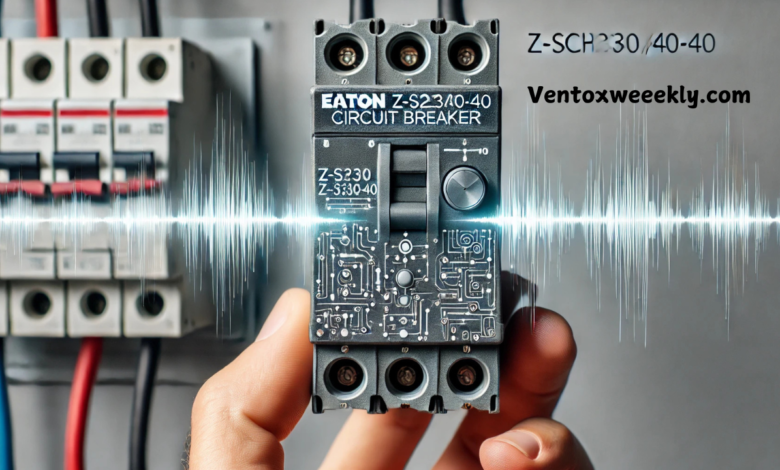Solving the Eaton Z-SCH230/40-40 Brummt Problem: Causes, Diagnosis, and Fixes

The Eaton Z-SCH230/40-40 is a widely used circuit breaker known for its reliability in protecting electrical systems from overcurrent and short circuits. However, one joint concern users report is the “brummt” or humming noise during operation. This article examines the potential causes of this issue, its significance, and how to diagnose and resolve it effectively.
Overview of the Eaton Z-SCH230/40-40
The Eaton Z-SCH230/40-40 is an advanced circuit breaker that provides:
- Voltage Range: Operates at 230V, suitable for residential, commercial, and industrial settings.
- Amperage Capacity: Handles loads up to 40A, ensuring protection for high-demand circuits.
- Safety Features: Equipped with overload and short circuit protection to safeguard electrical systems and connected appliances.
- Design: Compact and robust, with environmental protection ratings to resist dust, moisture, and other challenging conditions.
These features make the Z-SCH230/40-40 a versatile and dependable choice in electrical installations.
What Does Brummt Mean?
The German term brummt translates to “humming” or “buzzing” in English. This sound typically originates from the device itself and may indicate:
- Electrical Issues: Voltage fluctuations, harmonic distortion, or overloading.
- Mechanical Problems: Loose components, misaligned parts, or vibrations within the breaker housing.
While some level of humming is expected due to electromagnetic activity, persistent or loud noise might signal underlying problems requiring attention.
Common Causes of the Brummt Issue
- Voltage Fluctuations
- When the supply voltage deviates from the rated 230V, the circuit breaker can hum. Irregularities in the power grid or high-energy equipment in the circuit may be contributing factors.
- Harmonic Distortions
- Non-linear loads such as LED lights, computers, or industrial equipment can introduce harmonic distortions, causing the circuit breaker to emit a humming sound.
- Mechanical Vibrations
- Loose screws, improper mounting, or physical wear and tear can lead to vibrations, amplifying the humming noise.
- Magnetic Core Saturation
- If the breaker’s magnetic core is saturated due to excessive current flow, it can produce an audible hum.
- Environmental Factors
- Dust, moisture, or corrosive environments may deteriorate the breaker’s components, exacerbating operational noise.
Why the Brummt Issue Matters
Ignoring the humming noise can lead to:
- Device Failure: Persistent electrical or mechanical stress might damage the circuit breaker.
- System Malfunctions: Unresolved issues could compromise the safety of the entire electrical setup.
- Increased Energy Consumption: Faulty breakers may operate inefficiently, leading to higher energy bills.
Addressing the problem promptly ensures your electrical system’s safety, reliability, and efficiency.
Diagnosing the Eaton Z-SCH230/40-40 Brummt Issue
A systematic approach can help pinpoint the root cause of the humming noise:
- Visual Inspection
- Check for loose connections, damaged components, or improper mounting.
- Ensure the breaker is clean and free from dust or debris.
- Measure Electrical Parameters
- Use a digital multimeter to verify voltage, current, and resistance levels.
- Compare readings with the manufacturer’s specifications.
- Analyze Harmonics
- Employ an oscilloscope to detect waveform distortions caused by non-linear loads.
- Vibration Analysis
- Use vibration detection tools to identify mechanical instability.
- Tighten any loose parts or consider re-mounting the device securely.
- Load Testing
- Assess the breaker under varying load conditions to determine if excessive currents are causing the noise.
Troubleshooting the Brummt Issue
Depending on the diagnosis, you can implement the following solutions:
- Address Voltage Irregularities
- Install voltage stabilizers or surge protectors to manage fluctuations.
- Mitigate Harmonic Distortions
- Use harmonic filters to reduce distortions from non-linear loads.
- Ensure Proper Mounting
- Reinstall the breaker securely to minimize mechanical vibrations.
- Replace Worn Components
- Swap out aged or damaged parts to restore optimal performance.
- Consult a Professional
- If the issue persists, engage a licensed electrician or consult Eaton’s technical support.
Preventive Measures for Long-Term Performance
- Regular Maintenance
- Periodically inspect and clean the breaker to prevent dust accumulation or corrosion.
- Proper Installation
- Ensure the breaker is installed per manufacturer guidelines, with appropriate spacing and alignment.
- Load Management
- Avoid overloading circuits by evenly distributing electrical loads.
- Environmental Protection
- Install the breaker in areas with minimal moisture, heat, or chemical exposure.
Conclusion
The Eaton Z-SCH230/40-40 is a reliable circuit breaker that meets diverse electrical demands. While the brummt or humming issue can be concerning, understanding its causes and addressing them with proper diagnostics and troubleshooting ensures safe and efficient operation. You can maintain the breaker’s longevity and reliability by following preventive measures, providing uninterrupted protection for your electrical systems.
FAQs on Eaton Z-SCH230/40-40 Brummt
What does the brummt or humming noise mean in the Eaton Z-SCH230/40-40?
brummt refers to a humming or buzzing sound from the circuit breaker. Electrical issues like voltage fluctuations, mechanical problems such as loose components, or other factors like harmonic distortions or magnetic core saturation may cause this noise.
Is some humming noise from the Eaton Z-SCH230/40-40 normal?
Yes, some humming noise is expected due to electromagnetic activity during operation. However, persistent or loud noise could indicate underlying issues that must be addressed.
What are the common causes of the brummt issue in the Eaton Z-SCH230/40-40?
Common causes include voltage fluctuations, harmonic distortions from non-linear loads, mechanical vibrations from loose parts or improper mounting, magnetic core saturation due to excessive current flow, and environmental factors like dust or moisture.
How can I diagnose the brummt issue in the Eaton Z-SCH230/40-40?
Diagnosis involves a visual inspection for loose connections or damaged parts, measuring electrical parameters with a digital multimeter, analyzing harmonic distortions using an oscilloscope, checking for mechanical vibrations, and conducting load testing under varying conditions.
What should I do if I hear the brummt noise from the Eaton Z-SCH230/40-40?
First, a visual inspection is conducted, and electrical parameters are measured. If the noise persists, use tools to analyze harmonic distortions and vibrations. Install a voltage stabilizer or harmonic filter if the issue is related to voltage fluctuations or harmonic distortions.




